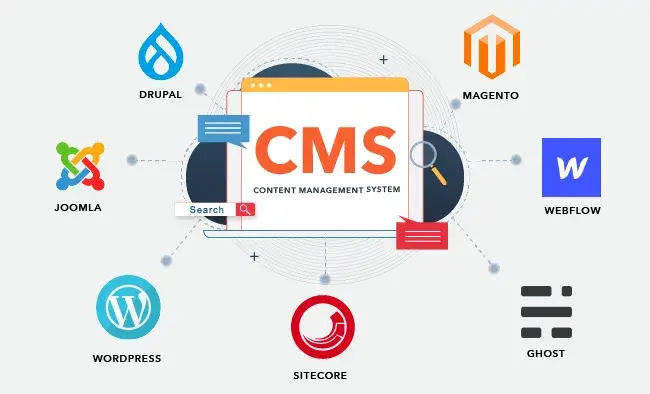1. Introduction
In today’s digital world, managing online content efficiently is essential for businesses, bloggers, and developers. A Content Management System (CMS) provides a user-friendly platform to create, edit, and manage digital content without requiring extensive technical knowledge. This article explores what a CMS is, how it works, its types, benefits, and popular CMS platforms.

Table of Contents
2. Definition of a Content Management System
A Content Management System (CMS) is a software application that enables users to create, manage, and modify digital content without needing specialized programming skills. It provides an interface for organizing text, images, videos, and other multimedia elements, making website management more efficient and accessible to non-technical users.
3. How a CMS Works
A CMS simplifies content management by offering a structured framework for content creation and storage. Typically, a CMS consists of two main components:
- Content Management Application (CMA): The user interface where content is created, edited, and published.
- Content Delivery Application (CDA): The backend system responsible for storing and delivering the content to users.
Users interact with the CMA to add or update content, while the CDA ensures that the published content is displayed correctly on the website or application.
4. Types of Content Management Systems
There are several types of CMS platforms, each designed to cater to different needs:
4.1 Traditional CMS
A traditional CMS, also known as a coupled CMS, integrates both the front-end and back-end within a single system. Examples include WordPress and Joomla. These platforms offer built-in themes, templates, and plugins for easy website customization.
4.2 Headless CMS
A headless CMS separates content management from content presentation. It provides content through an API, allowing developers to use the content across different digital platforms, including websites, mobile apps, and IoT devices. Examples include Contentful and Strapi.
4.3 Decoupled CMS
A decoupled CMS functions similarly to a headless CMS but provides some front-end capabilities, offering more flexibility while maintaining ease of use. Examples include Drupal and Kentico.
5. Key Features of a CMS
A robust CMS offers a variety of features that streamline content creation and management, including:
Security Features: Protects content and user data from cyber threats.
User-Friendly Interface: Simplifies content management for non-technical users.
Content Editing and Formatting: Provides a WYSIWYG (What You See Is What You Get) editor for intuitive content creation.
Media Management: Supports images, videos, and documents for enriched content.
SEO Tools: Helps optimize content for search engines with built-in SEO features.
Customization Options: Allows theme and template customization.
User Roles and Permissions: Enables role-based access control for collaborative content management.
Version Control: Tracks content revisions for easy rollback to previous versions.
6. Benefits of Using a CMS
A CMS offers numerous advantages, including:
- Ease of Use: Non-technical users can create and manage content effortlessly.
- Cost-Effectiveness: Reduces the need for dedicated developers for basic website maintenance.
- Improved Collaboration: Multiple users can contribute to content management simultaneously.
- Scalability: Suitable for both small businesses and large enterprises.
- SEO Friendliness: Enhances website ranking with built-in optimization tools.
- Customization and Flexibility: Allows businesses to create unique online experiences.
7. Popular Content Management Systems
Several CMS platforms are widely used worldwide, including:
| CMS Platform | Description | Best For |
|---|---|---|
| WordPress | The most popular open-source CMS with extensive themes and plugins. | Blogs, small to medium websites |
| Joomla | Offers advanced functionality and multilingual support. | Community websites, portals |
| Drupal | Highly customizable with robust security. | Large enterprises, government websites |
| Magento | Tailored for e-commerce businesses. | Online stores |
| Shopify | Hosted CMS for easy online store setup. | E-commerce startups |
| Wix | Drag-and-drop website builder with CMS capabilities. | Small businesses, personal sites |
| Contentful | Headless CMS with API-based content management. | Omnichannel content distribution |
8. How to Choose the Right CMS
Selecting the right CMS depends on various factors, including:
- Purpose and Use Case: Determine whether you need a blog, business website, or e-commerce platform.
- Ease of Use: Ensure the CMS is user-friendly and doesn’t require extensive technical expertise.
- Customization and Scalability: Choose a platform that can grow with your needs.
- Security Features: Opt for a CMS with strong security measures.
- SEO Capabilities: Ensure the CMS supports SEO best practices.
- Community and Support: Consider platforms with active user communities and professional support options.
9. Future Trends in CMS Technology
The CMS landscape is evolving with new technologies shaping content management. Key trends include:
- AI and Automation: AI-driven content personalization and automated workflows are becoming more prevalent.
- Voice Search Optimization: CMS platforms are adapting to optimize content for voice search.
- Integration with AR/VR: Augmented and virtual reality content management is on the rise.
- Increased Use of Headless CMS: More businesses are adopting headless CMS for omnichannel content distribution.
- Blockchain for Content Security: Decentralized content storage is gaining traction for enhanced security.
Conclusion
A Content Management System is an essential tool for businesses and individuals looking to manage digital content efficiently. Whether you need a traditional, headless, or decoupled CMS, understanding the different types and their features can help you make the right choice. With evolving trends like AI integration and voice search optimization, CMS platforms will continue to play a vital role in the digital space.